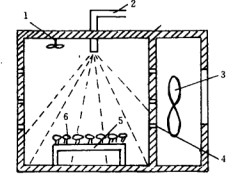Microwave drying process of peanut based on temperature control
1) conventional microwave drying
Using the self-made microwave temperature control drying equipment, the temperature measurement system and the quality measurement system are retained, and the relay control system is closed. The treated peanuts were put into it and dried under different power. The moisture content of peanuts was calculated by real-time peanut quality change. When the moisture content was less than 10%, the drying was stopped. Each group was tested three times, and the average value was calculated. The quality of peanut dried by conventional microwave was checked by sensory standards.
2) temperature controlled microwave drying
The dried peanuts were put into the oven by self-made microwave drying equipment. According to different power and temperature ranges, the peanut moisture content was calculated by real-time peanut quality change. When the moisture content was less than 10%, the drying was stopped. The average value of each group was calculated three times, and the quality of Peanut after microwave drying was checked by sensory standards.
1.4 drying rate
Drying rate refers to the vaporization of water quality per unit area.
U Gdx
Sd
In the formula, G is the mass of dry material in a batch of operations, kg, S is dry area, M2.
In this experiment, the self-made microwave temperature-controlled drying equipment was used to dry the treated peanuts with the lowest power (120 W) until no loss of water.
1.5 method of perception evaluation
The quality of drying is evaluated mainly from the color of peanut kernels.
1 test results and analysis
1.1 conventional microwave test results and analysis
The higher the microwave power, the steeper the drying curve, the shorter the drying time, the higher the microwave power and the higher the temperature. At the beginning of drying, the temperature rises rapidly, and when the temperature reaches the highest point, the moisture content has not reached the requirement. The microwave oven continues to work. After the temperature rises inertia, it returns to a relatively stable range.
1.2 temperature control microwave test results and analysis
In order to reflect the influence of drying power and temperature range on drying rate, the minimum drying power and the maximum drying power were selected as 1.20 W/g and 3.52 W/g, and the temperature range was 50-55 C and 35-40 C. The drying characteristics of peanut under microwave drying were observed.
The variation trend of moisture content with time in microwave drying under controlled temperature was similar to that of conventional microwave drying at drying power of 3.52 W/g and 1.2 W/g, but the drying time in different temperature ranges was also different.
In the conventional drying process, the drying rate is almost unchanged, and the drying temperature rises with constant drying rate. The drying rate fluctuates in a certain range under controlled temperature microwave drying to avoid excessive drying heat supply, resulting in burning phenomenon of peanut. The drying rate fluctuates differently in different drying power and temperature ranges. As shown in Fig. 5b, the range of fluctuation is large in the range of 50-55 C between 2-12 kg / (m2 h), and small in the range of 35-40 C between 1.5-5 kg / (m2 h). In Fig. 6b, it can be seen that the drying rate is the same as that of conventional microwave drying in the range of drying power 1.2 W/g and 50-55 C. The reason is that the maximum temperature of conventional microwave drying will not exceed 50 C under the drying power 1.2 W/g, so it is equivalent to continuous drying at 50-55 C.
In the range of 1.2 W/g and 50-55 C, the peanut microwave drying equipment was slightly scorched yellow on the outside when it reached the requirement, and the peanut was still bright red on the outside after drying at other temperatures and drying power, and the inside was milky white with intact germs.
Variance analysis of 1.3 temperature controlled microwave test
The effects of drying power and temperature range on the drying characteristics of peanut during temperature-controlled microwave drying were further analyzed.
According to the analysis of variance, when the power factor is 1.20 W/g, the temperature range is 50-55 C, the loss of water of peanut is more significant; but when the actual drying of peanut is 1.20 W/g and the temperature is 50-55 C, there will be a slight yellowing phenomenon; when the power factor is 1.20 W/g, the temperature range is 45-55 C.
After drying at 50 C, the peanut can retain its original color. The reason is that when the power factor is 1.20 W/g, even if the maximum temperature of conventional microwave drying will not exceed 50 C, so at 50 55 C, the drying rate is equivalent to continuous drying, the drying rate is continuously increasing, and in the 45 50 C range, because the drying process is interstitial, the drying rate wave in a certain range. This is consistent with the previous analysis.